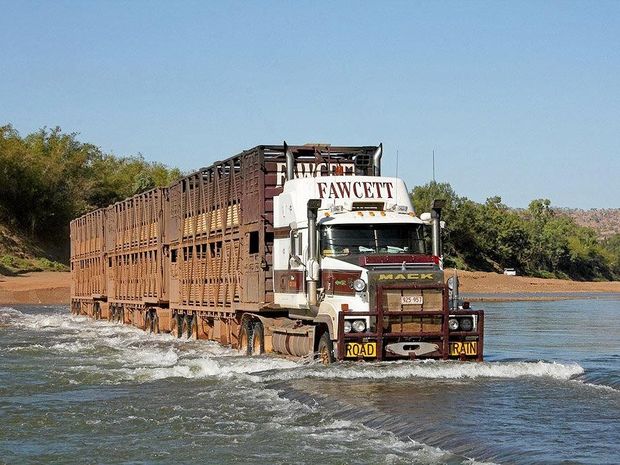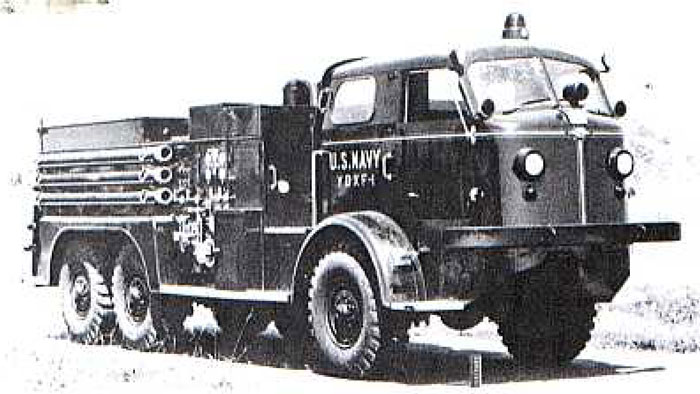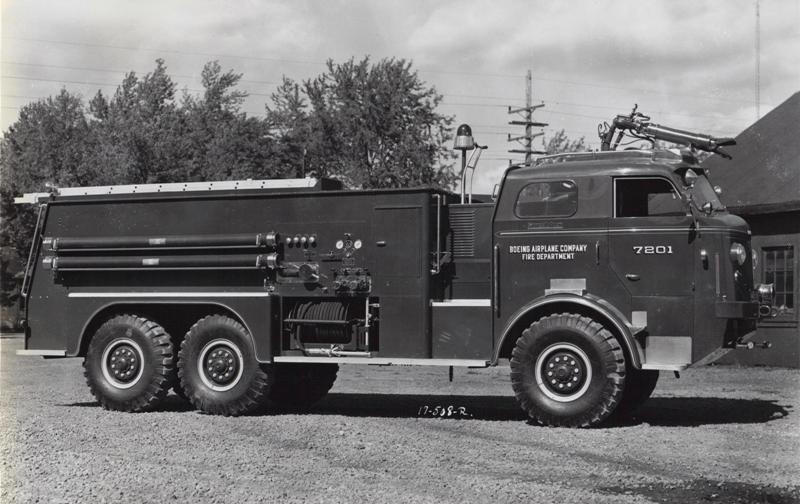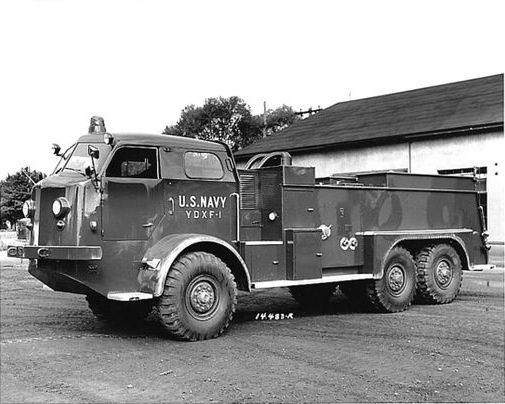
kscarbel2
Moderator-
Posts
18,886 -
Joined
-
Days Won
114
Content Type
Profiles
Forums
Gallery
Events
Blogs
BMT Wiki
Collections
Store
Everything posted by kscarbel2
-
Big Rigs / January 16, 2017 Fines for minor spillages under the Heavy Vehicle National Law (HVNL), towns complaining, arguments over liability for spillage between livestock carriers and primary producers. It's all a bit of a mess. We're talking about effluent, that mix of faeces and urine - cow, pig and sheep sh*t! New South Wales is hitting livestock carriers hard with $550 fines for dropping small amounts of effluent. These fines do not come under environmental or council legislation but under the improper restraint clauses of the HVNL. The future is clear, no matter how ridiculous it might be, effluent management systems for livestock hauliers are coming for all Australia, even if some years down the track for more remote regions. Industry associations like the Australian Livestock and Rural Transporters Association (ALRTA) and its state subsidiaries are jockeying to stem the surge towards national law by invoking the sharing of liability for effluent spillage "up the chain” within COR legislation. After all, "it's not our effluent”, one association member told Big Rigs, saying that the client owned the livestock and therefore any forthcoming effluent. The ALRTA says it has successfully argued to the Queensland Parliamentary Transport and Utilities Committee that the application of chain of responsibility laws to effluent control must be clarified. The Queensland Minister for transport has directed the NTC to clarify the matter within the next 12 months. "We are putting all options on the table including a full exemption under the Heavy Vehicle National Law.” Graham Hoare from Martin's transport is the south-east Queensland delegate for the LRTAQ and he said many livestock transporters are trying to keep ahead of the game, especially close to the metropolitan areas of south-east Queensland. "All the abattoirs and meatworks are in the Brisbane area and while we have fitted effluent tanks there is nowhere to empty them before we come into the metropolitan area,” he told Big Rigs. Mr Hoare agrees that the RMS in New South Wales is savage on effluent and said Queensland operators are trying to be proactive before legislation moves on the issue. All new livestock trailers must be fitted with effluent tanks "but we need somewhere to empty the tanks, like near the new Toowoomba bypass. That would be ideal”. While Mr Hoare says the industry is responding, the government and councils need to keep up and match the operator's investments in effluent facilities. "We want to lead the way and we are looking at the example of New Zealand to find out ways around this problem.” Mr Hoare said cattle producers and feed lot management are not buying into the liability of effluent, saying once the cattle are on the truck, it's the operator's responsibility. CEO of the Australian Livestock and Rural Transport Association based in Canberra is Matthew Munro. He said effluent control is a core part of the livestock transport process. He said the root cause locks in to the chain of responsibility and a cattle producer providing cattle to a transporter is an integral link in the chain. If there is a breach under the restraint clauses of the NHVL, that producer and their role fits into the HVNL definition of packer therefore carries responsibility under COR. He said while producers and livestock handlers are resisting liability, this is not an excuse to expect the transport operator to break the law. He uses the example of fresh seafood having to be carried from the coast several hundred kilometres to where it will be sold with the inherent need for it to arrive fresh. But in this case there is no expectation for the transport operation to break the speed limit legislation to get it to its destination in a more fresh condition. He said there is a need for transport operators, producers and livestock companies to work together to find a harmonious solution to this issue by having the cattle in the most appropriate condition, possibly after a curfew, before loading so keeping the best balance between livestock weights at the saleyard and the transport operator meeting the requirements of the law. The other alternative, says Mr Munro, is that the definitions under the HVNL be changed so that effluent is no longer covered under the restraint conditions. "Cattle producers are aware and they don't really want the transport operator to break the law, however their outlook is driven by market incentives and the way I see forward is a combination of the transport operator using effluent tanks on livestock trailers, that suitable dumping facilities for effluent are provided in appropriate places and the condition of livestock when loaded are suitable for transport in that there has been a curfew if the cattle are coming off green feed.” Mr Munro said the livestock associations are working towards setting up a set of guidelines that will keep both the producers and the transporters safe and that risk is assessed before the transport task. The south-east Queensland town of Kilcoy is currently an effluent hotspot. Big Rigs contacted the Somerset Regional Council for comment. Biosecurity The ALRTA is concerned that effluent is a prime vector of disease. For example in the case of a foot and mouth outbreak in Northern Australia, Mr Munro says that such an outbreak could cost the nation $60 billion. However effluent control and a simple alkaline or acid detergent wash at facilities could stop the spread of the disease. "$50 million spent now could save billions and entire industries in the future,” Mr Munro said, ending the report. .
-
. . . . . . .
-
Being reminded of Isuzu’s ceramic engine causes me to mention Cummins’ adiabatic engine research. Adiabatic is a thermodynamic term meaning no heat loss. The engine retains virtually all the heat created by the combustion of the fuel, and thereby requires no cooling system. Cummins and the United States Army experimented with such an engine in a five-ton model M813 6x6. The Army was interested in the project because it found that 60 percent of its vehicle-related failures involved problems with cooling systems. The Army’s Tank Automotive Command (TACOM) at Warren, Michigan, and Cummins jointly developed this first generation adiabatic engine by modifying the NHC250 normally found in the M813. The major changes involved making the pistons, cylinder liners, cylinder head, valves and exhaust manifolds out of a ceramic-metallic mixture which could tolerate temperatures exceeding 2,000 degrees Fahrenheit. By retaining most of the heat generated by fuel combustion and converting it into energy, the efficiency of the engine was improved almost 100 percent. A normal engine is only able to convert about one third of the heat created into usable power. The other two thirds is lost through the cooling system or out the exhaust pipe. Fuel economy was also improved with the adiabatic NHC250 version by almost 30 percent. Other advantages to the adiabatic NHC250, particularly in military applications, included the ability to install the engine within a vehicle in any position, since there was no requirement for airflow, or the need to be near a radiator for cooling. Without the need of a radiator, hoses and water pump, a weight savings of 338 pounds was realized with the adiabatic version. Lastly, because of the adiabatic engine’s very high combustion chamber temperatures, it could run well on a wide variety of fuels. Related reading: http://papers.sae.org/830314/ http://papers.sae.org/840428/ .
-
Mazda successfully eliminates the spark plug
kscarbel2 replied to kscarbel2's topic in Odds and Ends
That was Isuzu, as I recall. Please correct me if I'm wrong. ------------------------------------------------------------------------------------------------------------ October 27, 1983 Isuzu Motors said Thursday it has developed a ceramic internal combustion engine that is capable of generating more power than the conventional type while cutting fuel consumption by half. The prototype, a 1,995 cc turbo-charged diesel model, will be displayed at the Tokyo Motor Show opening Friday. Developed together with Kyocera, the leading Japanese industrial ceramics products maker, the combustion chamber of the ceramic engine is built with the highly heat-resistant material that is capable of withstanding up to 2,000 degrees (C) of heat without a cooling system. Test results show that the ceramic engine can generate 30 percent more power at half the level of fuel consumption. Isuzu, however, stressed that the model is only a prototype and that the company still has to iron out durability and other unspecified technical problems before the engine can be put into commercial use. Specifically Isuzu engineers will have to make the ceramics more durable. The material, while highly heat-resistant, cracks easily, auto experts said. The Isuzu spokesman confirmed durability is among the unresolved technical problems but indicated the Isuzu engineers would be able to overcome them. ------------------------------------------------------------------------------------------------------------ United States patent on ceramic engine design - https://www.google.com/patents/US5063881 ------------------------------------------------------------------------------------------------------------ -
Motor Panels is linked to North America. Connecting the dots of Mack conventional cab supplier history, Sheller-Globe purchased Motor Panels of the UK and then put the Norwalk Mack cab plant under its new Motor Panels division. Then that division was sold in 1989 to UK-based CH Industrials, which was sold in 1991 to UK-based Mayflower Vehicle Systems, which was sold in 2005 to Commercial Vehicle Group (CVG). CVG had no prior history of assembling cabs, was willing to do so. Likewise Bendix, who had never produced cabs, has assembled White Xpeditor cabs for Autocar in Huntington, Indiana since 2008. Currently, CVG stamps and assembles the cabs under contract in a run-down plant in Kings Mountain, North Carolina (originally located there to supply Mack Trucks' Winnsboro, South Carolina plant 70 miles away), from which they are trucked up 470 miles to Macungie.
-
Scania Group Press Release / January 16, 2017 What ingenious engineering lowers oil consumption and extends engine life, and has been around for the last 40 years? .
-
- 1
-

-
DAF Trucks Press Release / January 16, 2017 .
-
Kenworth Truck Company Press Release / January 16, 2017 Two new Kenworth T880S set-forward front axle mixers are Kenworth’s showcase construction trucks at the upcoming 2017 World of Concrete Show Jan. 17-20 at the Las Vegas Convention Center. Kenworth’s booth (No. C6020) will feature a 5-axle Kenworth T880S mixer with a 2017 Paccar [DAF] MX-11 430-hp engine with 1,650 lb-ft of torque, Allison 4700 RDS 7-speed automatic transmission, 20,000-pound front axle and suspension, 46,000-pound rear axle and suspension. Also on display will be a 4-axle Kenworth T880S mixer equipped with a 2017 Paccar [DAF] MX-13 405-hp engine with 1,450 lb-ft of torque, Allison 4500 RDS 6-speed automatic transmission, 20,000-pound front axle and suspension, and 46,000-pound rear axle and suspension. “The rugged and reliable T880S is designed to deliver excellent performance in vocational applications where every incremental pound of payload delivered contributes directly to the bottom line, and excellent maneuverability and visibility are valued,” said Kurt Swihart, Kenworth marketing director. “With a 114-inch BBC and best-in-class 28-inch bumper setting, contractors can operate highly productive mixer trucks that easily meet the Federal Bridge formula with minimum tare weight and the capability for enhanced body installations.” The bumper setting is critical to spec’ing Bridge Formula chassis so they remain under the 40-foot length limit, Swihart added. The weight rating for the set-forward front axle on the T880S ranges from 14,600 pounds to 22,800 pounds. Contractors can also choose single, tandem or tridem drive axles, and a wide variety of factory-installed lift axles, to meet their jobsite requirements. The T880S provides clear back-of-cab options that make it easy to configure truck bodies, handle extreme loads and make it easier for body upfitting. “Contractors will like that the new model’s lower hood profile that provides their drivers up to four feet of additional ground visibility,” Swihart said. “That can be particularly important for drivers operating in the tight confines of many job sites.” The T880S is standard with the 12.9-liter MX-13 engine, which provides up to 510-hp and 1,850 lb-ft of torque. For weight-sensitive applications, the 10.8-liter MX-11 engine saves 400 pounds compared to a 13-liter engine, offers an impressive power to weight ratio, and low fuel consumption. The MX-11 with up to 430-hp and 1,650 lb-ft of torque is well-suited for ready-mix trucks. .
-
The Electronic Logging Device (ELD) Controversy
kscarbel2 replied to kscarbel2's topic in Trucking News
OOIDA denied request for ELD rehearing Fleet Owner / January 13, 2017 Group still contends that government reasons for mandating electronic ELDs are weak and fail to justify violating the Fourth Amendment rights of professional truck drivers. The Owner-Operator Independent Drivers Association (OOIDA) said its petition with the U.S. Court of Appeals for the 7th Circuit for a rehearing of its legal case against the electronic logging device (ELD) mandate was denied this week. The three-judge panel had ruled against OOIDA’s original lawsuit back in October, prompting the group to file this now-defunct petition in December. “It’s clear now that we have to pull out all the stops to convince lawmakers and the new Trump administration of the need to set aside the ELD mandate,” Jim Johnston, OOIDA’s president and CEO, said in a statement, adding that his organization is preparing for the “next phase” of its ELD mandate challenge with an appeal to the Supreme Court. Yet he added that OOIDA will also continue to pursue the issue on the congressional side. OOIDA still contends that “the government’s excuses for mandating ELDs are weak” and fail to justify violating the Fourth Amendment rights of professional truck drivers. Todd Spencer, OOIDA’s executive vice president, told Fleet Owner in an interview late last year that there’s been far more “take” than “give” in recent years where regulatory oversight of trucking is concerned. But he’s hopeful the changeover to the Trump administration might encourage a “fresh look” at highway safety as a whole. “The regulatory regime has been on steroids for the past few years. Is there a cumulative effect? There sure is,” he explained. “The kind of mindset in the regulatory/legislative community right now is that more is better,” Spencer stressed. “But although there’s been more regulation and more compliance than there’s ever been, crash numbers keep going up, not down. So what the very people making all of these rules should be asking is, ‘What the hell is going on?’” -
These were produced in 2003 (when Volvo terminated E9 production) or prior. Armed forces routinely purchase an incredibly large number of spare parts, and purge them when they retire the trucks, tanks, ect. that used them. This is why military truck ownership makes for a relatively inexpensive hobby. New old stock (NOS) parts generally have high availability and relatively low cost.
-
Nikkei / January 9, 2017 Mazda will introduce a new gasoline engine at the end of 2018 that offers 30% better fuel efficiency by using pressure, not spark plugs, to ignite fuel. This will be the first practical application of the technology, called homogeneous charge compression ignition. Though Mazda is developing electric vehicles too, the automaker thinks the internal combustion engine will continue to account for the majority of new-vehicle sales for the foreseeable future and that the company's technology will give it a leg up on the competition. Homogeneous charge compression ignition, or HCCI, is the black art of of internal combustion engines that aims to produce diesel-like fuel efficiency for the cost of gasoline. Although some of its competitors have developed and subsequently given up on the tech, Mazda confirmed that the next-generation of “SkyActiv” engines will employ HCCI technology, improving fuel economy by 30 percent and at the same time reducing exhaust emissions. According to Nikkei, a new SkyActiv family of engines is set to debut under the hood of the next-gen Mazda3 in 2018 before making its way into other vehicles. In simple terms, an engine that uses HCCI burns the air/fuel mix using pressure instead of with spark plugs, just like a diesel. At 14:1, Mazda's gasoline engines already have some of the highest compression ratios out there, but a move to HCCI means cranking up the compression to 18:1. While the tech sounds relatively straightforward, using HCCI means dealing with a number of side issues. It's one of those "on paper" ideas that compounds problems when put into practice. Heat, revs, and fuel must all be carefully managed as gasoline doesn't burn the same way as diesel. If the new HCCI engines are successful, Mazda will have out-engineered GM, Daimler, and Hyundai, all of which have tried and failed to develop HCCI engines in a cost-effective package. With the market moving towards electrification, it's interesting to see Mazda still focusing so heavily on traditional internal combustion gasoline engines. It's an indication of where they see the market heading for the next few years. Although the automaker has been hesitant to move forward with hybrid and electric powertrains, Mazda will begin mass production of electric vehicles in 2019.
-
VW's Winterkorn Directly Involved, Damning Dieselgate Revelations Say Forbes / January 15, 2017 If you are looking for written proof for the involvement of Volkswagen’s former CEO Martin Winterkorn in the dieselgate coverup, look no further than this morning’s edition of Germany’s BILD Zeitung. Two months before the scandal became public, Volkswagen planned a highly selective disclosure strategy, the paper says in its Sunday edition. The usually well-informed newspaper cites and shows PowerPoints from a presentation chaired by Martin Winterkorn himself. The revelation could put arrested Volkswagen manager Oliver Schmidt in U.S. jail for many years, and it could cost Volkswagen another $10 billion. The documents are from a July 27, 2015 crisis meeting at Volkswagen’s headquarters in Wolfsburg. This meeting gained prominence when VW manager Oliver Schmidt was arrested a week ago in Miami. In its complaint against Schmidt, the FBI alleges: “On or about July 27, 2015, SCHMIDT and other VW employees presented to VW’s executive management in Wolfsburg, Germany, regarding the existence, purpose and characteristics of the defeat device,” the FBI claims, continuing that “in the presentation, VW employees assured VW executive management that U.S. regulators were not aware of the defeat device. Rather that advocate for disclosure of the defeat device to U.S. regulators, VW executive management authorized its continued concealment.” Not exactly, says the document revealed today. The documents describe an unemotional planning session, coldly calculating the “chances” and “risks” of possible disclosure strategies vis-à-vis the U.S. regulator. The presentation did not traipse around. “No change of raw emissions in acoustic mode” a briefing document is quoted. BILD’s translation: “The exhaust is blown out unfiltered.” At Volkswagen, “acoustic mode” was the code word for the defeat device cheater software. The meeting also was fully informed about the number of affected cars: “505,874 vehicles” in North America, a slide said. The “defensive” strategy is paraphrased by BILD as “continue lying for a while.” As its chances, the chart named an assured approval of new Volkswagen models. Its risks were “very high financial penalties.” The “offensive” strategy was one of full disclosure. As its chances, lower penalties beckoned. Its risks were defined as long delays in the type approval of a new model generation. Meeting participants told BILD in unison that the meeting decided on the “offensive” strategy: Full disclosure. Volkswagen brand chief Herbert Diess, a fresh arrival from BMW, offered his assistance in the coming clean, the report said. However, that decision did not survive a few days. Says BILD: “Another manager prevailed: The now arrested Oliver Schmidt volunteered to take care of the problem. In an internal note dated July 30th, suddenly there was not a single word about full disclosure in front of the U.S. regulator. The note says that “Professor Winterhorn” approved the following procedure: “Selective disclosure of the Gen 1 and Gen 2 issues.” Also, Schmidt was asked to clear the “wording” with a Winterkorn confidante, and a Volkswagen lawyer.” The July 27 presentation was given by a Volkswagen engineer named by BILD only as “Thorsten D.” a treatment required for German suspects until convicted. The FBI named a Thorsten Duesterdieck in its criminal complaint against Oliver Schmidt. BILD bases its story on interviews with meeting participants by a German prosecutor, and on its own interviews. “We talked about something illegal installed into our cars,” one participant is cited by BILD. The July 27 meeting had been talked about before. However, Volkswagen and Winterkorn used to remember only a brief conversation where Winterkorn was supposedly told that everything was under control. In a court in Braunschweig, Volkswagen did confirm the July 27 meeting, and the participation of Winterkorn and Diess. In a court document, Volkswagen declared that “neither the content of this informal meeting nor the exact timing of the participation of the board members can be reconstructed in detail.” Thorsten D. recalls the meeting differently. He expected to be “blown off” after the third chart, he told prosecutors. Instead, Winterkorn’s reaction to the presentation was “surprisingly calm,” the report said. “You and your software,” Winterkorn snapped later in the meeting at a Volkswagen engineer who was part of the cheater code development, said BILD. In Germany, Volkswagen is fighting some 1400 lawsuits brought by stockholders, alleging that the company did not disclose material facts in a timely manner. Volkswagen is being sued for between $9 and $11 billion. Along with Volkswagen’s admission of guilt as part of the recent settlement with the US DOJ, today’s revelation will not help its cause in German courts. On top of the U.S. settlement, this would total to some $30 billion, money the company could have used to build 20 new factories, or to develop 30 new model generations, mehr oder weniger. Reports of Winterkorn’s direct involvement in the cover-up do not lift the spirits of Volkswagen managers who had to endure a staccato of dropping shoes for more than a year. They were told that it was a rogue group among theirs, all the while executives quietly sailed out of the door on golden parachutes. Many Volkswagen managers cannot take it anymore. “This is insane,” sighed a Volkswagen exec over the phone from Wolfsburg after he read the story in this morning’s BILD am Sonntag. “With that, the positions of Diess, Müller, Stadler and Pötsch should no longer be tenable, wouldn’t you say?” the exec hoped, listing the really top brass at Volkswagen. Only the future will have that answer. For the Wolfsburg manager, the answer can’t come soon enough: “The field needs to be freshly plowed. That daily lawn mowing is Scheisse.”
-
Automotive News / January 16, 2017 The upcoming diesel version of the Chevrolet Cruze will be General Motors' first non-hybrid vehicle since the 1990s with an EPA-certified fuel economy rating over 50 mpg on the highway. GM is awaiting EPA certification of the car's fuel economy ratings ahead of a spring launch. The Cruze's new lightweight 1.6-liter turbo-diesel engine will be optional on the Cruze hatchback and sedan. Asked at the Detroit auto show about the Cruze diesel's highway rating, GM product development chief Mark Reuss said: "I think it will start with a 5." The early 1990s Geo Metro XFi (rebadged Suzuki Cultus) is the last time GM had a non-hybrid car that had an EPA highway rating in the 50s. The Cruze's new turbodiesel engine has an aluminum block and is rated at 137 hp and 240 pounds-feet of torque. It will be offered with either a nine-speed automatic transmission or a six-speed manual. The Cruze manual will have a higher EPA rating than the automatic. In 2015, the last time Chevrolet offered a Cruze diesel, the car had a 2.0-liter engine with a cast iron block paired with a six-speed automatic transmission. With the 2017 model, most of the power comes on low in the rpm range. In addition to high fuel economy, engineers also concentrated on refinement. "We've taken a totally different approach to address noise at the source," said Cruze diesel chief engineer Mike Siegrist. The cam timing details, for instance, are at the back of the engine, instead of the front. And to keep diesel chatter low, the fuel injectors shoot as many as 10 squirts of fuel per stroke. .
-
Mack E6, E7 vs their competition
kscarbel2 replied to sodly's topic in Antique and Classic Mack Trucks General Discussion
An MH Ultra-Liner powered by an E6-350 (4VH) ties with the Value-Liner as being my favorite Mack trucks of all time. -
The U.S. Navy’s requirements for cross-country 6x6 pumpers led to the development of the American LaFrance Model YDXF-1 foam pumper. Built in 1954, it was powered by the same 320 horsepower ( at 2,800 rpm) dual-carbureted Continental Model S680-1 820 cubic inch six-cylinder engine used in several other military trucks. The pumper used American LaFrance’s 700 Series civilian cab, mounted high to provide clearance for the truck’s driven front axle. With 14.00x20 tires, it had 14 inches of ground clearance and excellent angles of approach and departure resulting in good off-road mobility. A synchronized Spicer five-speed transmission and Timken T13 two-speed transfer case were paired with Timken HM240-HX five-ton military axles (6.443 ratio). The truck’s chassis was based on the military five-ton 6x6. With a 190-inch wheelbase, the YDXF-1 was a versatile rig despite its 37,000 pound (16,783 kg) gross weight. The pumper carried 750 galons of foam concentrate which was supported by a 2,000 gallon-per-minute pump, and mounted a 750 gallon-per-minute main water pump with 1,200 feet of hose. The YDXF1 was tested at Aberdeen Proving Ground, Maryland, in the summer of 1954. .
-
Mack E6, E7 vs their competition
kscarbel2 replied to sodly's topic in Antique and Classic Mack Trucks General Discussion
The 11 liter (11.01 liter/672 cu.in.) Mack E6 and 12-liter (11.9 liter/728 cu.in.) E7 were able to meet 95 percent of customer applications, offering impressive power, torque and class-leading fuel economy combined with light weight and lower operating costs. For those needing a larger powerplant, we offered the legendary E9 V-8, rather than a large six like Cummins. Fast forward to year 2017, owing to new technologies, we're able to "reliably" get more horsepower out of 11 liters than we were able to in 1985 when we launched the superb E6 4V. The four valve head E6-350 with an American Bosch pump remains one of my favorite engines. I love selling V-8s. And our customers love driving them. But for most operators, a 420hp 11-liter will make their accountants smile the most, the same way the accountants at Chemical Leamon, Matlack and Overnite used to smile. -
The New York Times / January 16, 2016 The FBI said Monday it has arrested the wife of the man who carried out a deadly terrorist attack in Orlando, Fla., and charged her with obstructing the investigation of the mass shooting. Noor Salman, whose husband, Omar Mateen, killed 49 people and wounded dozens in an Orlando nightclub that was popular with gays, was also charged with aiding and abetting by providing material support. She was taken into custody by FBI agents at her home outside of San Francisco, where she had been living with her young son. Prosecutors had been weighing charges against her for months in the aftermath of the attack by her husband on June 12, 2016. Investigators interviewed Salman for hours after the attack and came to believe she was not telling the truth about her husband’s plans to carry out the rampage [so why wasn’t she taken into custody then?]. She is expected to make an initial appearance on Tuesday at a federal court in Northern California. The Justice Department’s decision to prosecute Salman, 30, ends part of the mystery that has surrounded her since the first days after the attack, when she became a central subject of the wide-ranging investigation into her husband. In an interview last year with The New York Times, Salman claimed that she “unaware of everything” in connection with the attack. Salman said she had accompanied her husband to Orlando with their child once when he scouted the club but did not know the purpose of the trip. On the day her husband drove to Orlando, she claimed he said he was going to visit a friend, named Nemo, who lived in Florida. But Nemo was not living in Florida at the time, a fact Salman said she did not know. She also said she had no reason to suspect that ammunition he bought in the days leading up to the attack was to be used in the shooting, given that her husband was a security guard who frequently purchased ammunition. On the day of the shooting, she bought her husband a Father’s Day card, expecting him to return that evening. Her lawyers believe that supports her story that she did not know about the attack [planned alibis]. During his attack, Mateen used Facebook to pledge his allegiance to ISIS. The FBI doesn’t believe that Mateen, age 29, received any specific training or support from ISIS. Salman married Mateen in a ceremony near her childhood home in Northern California, a second marriage for both. After the wedding, they moved to Fort Pierce, Florida. Their marriage in 2011 caused consternation among some of Salman’s relatives, mostly because of her Palestinian heritage and Mateen’s ancestral ties to Afghanistan. Salman claimed that her husband beat her repeatedly and verbally abused her.
-
IVECO in top three Dakar finish Iveco Trucks Press Release / January 16, 2017 IVECO trucks have once again performed strongly in this year’s gruelling Dakar Rally, taking out third and fourth positions after 9,000 kilometres of racing across South America’s roughest terrain. Piloted by Dutchman Gerard de Rooy, the IVECO Powerstar finished on the podium only 41m 19s short of winner Eduard Nikolaev, after 12 days of close racing. This year’s third placing – which included two stage victories – adds to de Rooy’s wins in 2016 and 2012 and is seen as an excellent result given the multiple punctures his truck suffered over the course of the event. Also performing strongly this year was Argentinian Federico Villagra, in another IVECO Powerstar – he finished the event in fourth position, less than 20 minutes behind de Rooy. In total, six IVECO trucks competed in the 2017 instalment of Dakar, with all completing the event, a testament to the manufacturer’s strength and reliability. Iveco Australia Marketing Manager, Darren Swenson, says IVECO’s off-road range has tremendous pedigree and is second to none in the Australian market. “Local buyers have a lot of choice from IVECO when it comes to off-road vehicles, with many models available across the light, medium and heavy duty weight classes,” he said. “Beginning with the new car licence Daily 4x4 (optional light truck 5.5t GVM also available), the range then moves to the Eurocargo 4x4 as successfully used by Daryl Beattie Adventures and a growing number of emergency service organisations. “For heavier duty applications up to 33t GVM, there’s the Trakker 4x4 and 6x6 range which is increasingly being put to work in mining and exploration applications. And in the even heavier weight classes up to 48t GVM, we have the Astra 6x6 and 8x8 variants which are taking on roles in off-road tipper work, drilling, exploration and similar. Mr Swenson says the Dakar rally was helping to grow awareness of IVECO’s off-road credentials. “IVECO is gaining a very solid reputation in demanding off-road racing such as Dakar, and increasingly this is leading to improved sales across the range and a growing list of satisfied local customers.” Overall Standings – Dakar 2017 1. Eduard Nikolaev (Kamaz) 27h 58m 24s 2. Dmitry Sotnikov (Kamaz) +18m 58s 3. Gerard de Rooy (IVECO) +41m 19s 4. Federico Villagra (IVECO) +1h 00m 04s 5. Airat Mardeev (Kamaz) +2h 26m 50s ----------- 16. Ton van Genugten (IVECO) +6h 58m 03s 17. Wuf van Ginkel (IVECO) + 8h 19m 48s .
-
Owner/Driver / January 16, 2017 The trucks at the 2017 Dakar Rally brought thrills and spills as they battled across 9,000 kilometres of arduous South American terrain. Russian truck manufacturer KAMAZ took out first place in the 2017 Dakar Rally truck category, with Iveco achieving third and fourth place following a 2016 win. Piloted by Dutchman Gerard de Rooy, the IVECO Powerstar finished on the podium only 41m 19s short of winner Eduard Nikolaev, after 12 days of close racing. This year’s third placing to de Rooy’s wins in 2016 and 2012 and is seen as an excellent result given the multiple punctures his truck suffered over the course of the event. Also performing strongly this year was Argentinian Federico Villagra, in another IVECO Powerstar, as he finished the event in fourth position, less than 20 minutes behind de Rooy. In total, six IVECO trucks competed in the 2017 instalment of Dakar, with all completing the event, a testament to the manufacturer’s strength and reliability. Iveco Australia Marketing Manager, Darren Swenson, says IVECO’s off-road range has tremendous pedigree and is second to none in the Australian market. "Local buyers have a lot of choice from IVECO when it comes to off-road vehicles, with many models available across the light, medium and heavy duty weight classes," he said. "Beginning with the new car licence Daily 4x4 (optional light truck 5.5t GVM also available), the range then moves to the Eurocargo 4x4 as successfully used by Daryl Beattie Adventures and a growing number of emergency service organisations. "For heavier duty applications up to 33t GVM, there’s the Trakker 4x4 and 6x6 range which is increasingly being put to work in mining and exploration applications. And in the even heavier weight classes up to 48t GVM, we have the Astra 6x6 and 8x8 variants which are taking on roles in off-road tipper work, drilling, exploration and similar. Mr Swenson says the Dakar rally was helping to grow awareness of IVECO’s off-road credentials. "IVECO is gaining a very solid reputation in demanding off-road racing such as Dakar, and increasingly this is leading to improved sales across the range and a growing list of satisfied local customers." See below for results and a video of the top Dakar 2017 truck moments! Top Five Truck Category Standings – Dakar Rally 2017 1. Eduard Nikolaev (Kamaz) 27h 58m 24s 2. Dmitry Sotnikov (Kamaz) +18m 58s 3. Gerard de Rooy (IVECO) +41m 19s 4. Federico Villagra (IVECO) +1h 00m 04s 5. Airat Mardeev (Kamaz) +2h 26m 50s . .
-
- 1
-

-
Owner/Driver / January 16, 2017 Working in a transport yard from age 10 gave Troy McLean a much-needed truck education before eventually getting behind the wheel. Now he’s in his own 2008 T908. Troy McLean spent 13 years working as a driver but always had the desire to have a truck he could call his own. That finally happened 13 years ago and he’s now doing runs in a 2008 Kenworth T908. "I first looked at buying my own truck when I was around 21 or 22 years of age," Troy recalls. "Things didn’t come together back then and I got talked out of it. Anyway, the opportunity arose so I jumped at it. "We had looked at being owner-drivers a couple of times and hadn’t made the move. "My wife Jackie said that if I didn’t do it this time, not to talk about it again," he laughs. "I think Jackie had had enough." That first truck, a 1994 Ford LTL Kentucky, had a 425 Cat under the bonnet. Through word of mouth, Troy heard of a business that was seeking an operator to cart plasterboard. He did his first trip as an owner-driver and, pulling up in front of the company’s factory, approached after he’d heard they were looking for someone to do their cartage. He has been with them ever since. Troy, however, had his heart set on a Kenworth, so the LTL was traded in on a K104 Aerodyne. This was joined by a new Western Star truck and dog tipper unit. Under the name of TJ & JJ McClean, the couple employed a driver that Troy put to work on the Calder Freeway extension to Bendigo. Eventually a second Aerodyne joined the fleet but then Troy decided to consolidate and go after the truck he always wanted. He sold the two Aerodynes and Western Star and bought a T908. It has a Cummins ISX EGR set at 620hp up front, an 18 speed manual gearbox with the rear end riding on Kenworth’s 8 bag air suspension. Troy lives at Campbell’s Creek near Castlemaine and uses the 908 to pull a tautliner, doing either one or two trips a day between Bendigo and Melbourne. "I had always been working towards getting a ‘9-0’. I just wanted that long bonnet," he says. "It’s as good as I thought it would be. I just love it and it’s beautiful to operate, a real driver’s truck." The T908 is impeccably presented and looks brand new, Troy admitting it’s fairly well pampered. It gets washed and polished regularly, with either Troy cleaning it himself or son Bradley helping out. Troy says Bradley, an apprentice panel beater, is absolutely "truck mad". It’s a real family affair, with Jackie handling all the bookwork. "I’ve never really done any of that side of it," Troy admits. "Jackie has always looked after the office work. "I just come home and put the dockets on the bench and she does the rest. She is the biggest asset I have." With the T908 looking the goods, it was a no-brainer to take it to last year’s Rotary Castlemaine Truck Show. "Jackie said as long as we’ve got a truck, it’ll be at our local truck show." .
-
Stage 11 Results MAZ Trucks Press Release / January 13, 2017 Stage 11 of DAKAR-2017 is finished, there were two specials in 114 km and 173 km, the total length was 754 km. The dunes of San Juan were the last ones that the competitors confronted on the route of the Dakar 2017, dotted over fifty kilometres at the start of the special. S. Viazovich (511) took the 18th place ad is at the 13th position in the general ranking. A.Vasilevski (522) is the tenth at the stage and in the general ranking he enters the 6th place. A. Vishneuski (533) is at the 16th position at the stage, and in general ranking he takes the 19th place. Ahead is the final twelveth stage from Rio Cuarto to Buenos Aires. All the competitors threw themselves into the adventure and now they are going to become heroes. The 64-km long special does not include any pitfalls – all the competitors need to do is go the distance in order to enjoy a special stage's finishing line in the heart of the bivouac. At the end of a long link stage, the podium ceremony in Buenos Aires will take place in front of the Argentinean Automobile Club. The total length is 786 km, the special is 64 km. Starting time for the final stage: 511 (S.Viazovich / P.Haranin / A.Zhigulin) – 10:06:00 (16:06:00 Minsk time) 522 (A.Vasilevski / D.Vikhrenko / A.Zaparoschanka) – 09:59:00 (15:59:00 Minsk time) 533 ((A.Vishneuski / M.Novikau / A.Neviarovich) – 10:12:00 (16:12:00 Minsk time). .
-
Stage 10 Results MAZ Trucks Press Release / January 12, 2017 511 (S.Viazovich / P.Haranin / A.Zhigulin) – 4 th place at the stage (time gap 12:51); 12th position in the general ranking (time gap 03:37:40 ). 522 (A.Vasilevski / D.Vikhrenko / A.Zaparoschanka) – 6th place at the stage (time gap 22:51); 7th position in the general ranking (time gap 02:03:21). 533 (A.Vishneuski / M.Novikau / A.Neviarovich)– 32nd place at the stage (time gap 04:37:11); 21st position in the general ranking (time gap 10:18:10) . .
BigMackTrucks.com
BigMackTrucks.com is a support forum for antique, classic and modern Mack Trucks! The forum is owned and maintained by Watt's Truck Center, Inc. an independent, full service Mack dealer. The forums are not affiliated with Mack Trucks, Inc.
Our Vendors and Advertisers
Thank you for your support!



.thumb.jpg.bbc72ab893b079af7959c811964caa82.jpg)
.thumb.jpg.bbc30f6333f24754dc9f3d457708265f.jpg)
.thumb.jpg.997e23548ab77e937b60e2613ef835eb.jpg)
.thumb.jpg.daddd03defffab59ece487510bd978ec.jpg)
.thumb.jpg.0149f90ed26e1a41070e183aecbdd83b.jpg)
.thumb.jpg.58b570dd16e028b1ff742dff59bc3a11.jpg)
.thumb.jpg.26915c0c4b3e03b1733cc023f88dfea4.jpg)
.thumb.jpg.eca46892ded4b18ef64ed9af9943a0c0.jpg)











